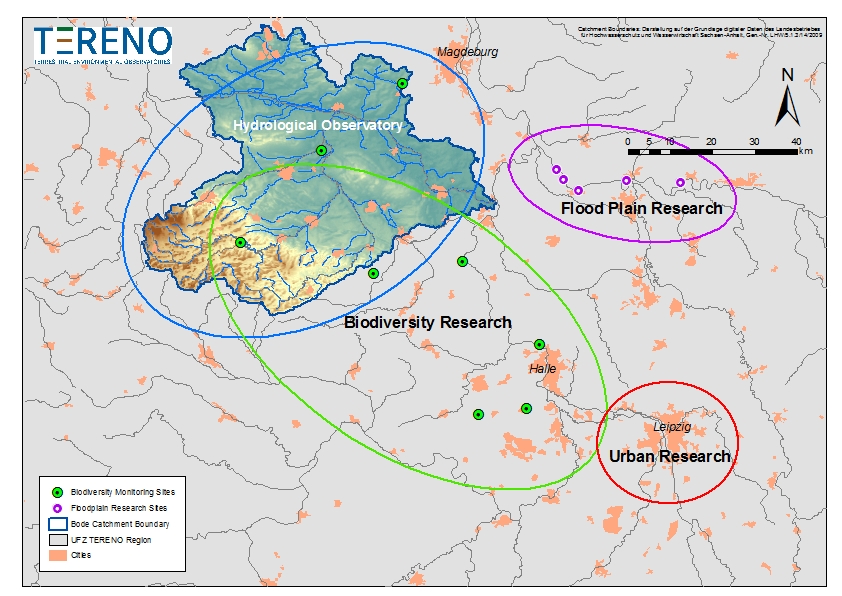Harz/Central German Lowland Observatory
The Harz/Central German Lowland Observatory, located in Central Germany, covers an area of approx. 25.700 km². The region is characterized by pronounced gradients of temperature, precipitation, land use and urbanity. The monitoring, observation, and research activities within the Harz/Central German Lowland Observatory are concentrated in four main corridors (see figure 1; click opens a larger image) - a specific flood plain research plattform, a number of sites mainly focussed on biodiversity related research, the metropolitan area of Leipzig and Halle as focus area of urban research at the UFZ, and the hydrological observatory in the catchment of the river Bode.
 The observation of climate induced changes in the hydrological regime is one of the major tasks within TERENO activities. The hydrological research within the Harz/Central German Lowland Observatory is concentrated in the catchment area of the river Bode (catchment size approx. 3.300 km²). The detection of scale dependencies in flowpaths, run-off generation or residence times requires scale-related approaches of observation. Therefore, a nested approach including small process plots (< 2 km²), meso-scale subcatchments (approx. 100 km²) up to the scale of the complete Bode catchment will be established. A more detailed description of the hydrological observatory and the several intensive test sites can be found here.
The observation of climate induced changes in the hydrological regime is one of the major tasks within TERENO activities. The hydrological research within the Harz/Central German Lowland Observatory is concentrated in the catchment area of the river Bode (catchment size approx. 3.300 km²). The detection of scale dependencies in flowpaths, run-off generation or residence times requires scale-related approaches of observation. Therefore, a nested approach including small process plots (< 2 km²), meso-scale subcatchments (approx. 100 km²) up to the scale of the complete Bode catchment will be established. A more detailed description of the hydrological observatory and the several intensive test sites can be found here.
Apart from the hydrological research the observation of biodiversity dynamics in the context of land use and climate change is another important research field in the observatory. A network of long-term monitoring and research sites along a main transect (with respect to the climatic gradient) is implemented.
Different disciplines are integrated in urban systems research, coupling natural, social and environmental health research. In a systematic approach the understanding of the complexity of each of the disciplinary perspectives in amplified. Studies are carried out on different spatial and temporal scales, to reflect processes on their regional and local scale distinctively. The methodological transferability on other study areas is a further goal which sheds light on the different cultural and social contexts.
Intensive test sites in the flood land region of the river Elbe focus on effects of climate change on hydrological extremes and vulnerable systems. Here, the researchers investigate small-scale spatial and temporal dynamics with respect to larger-scale matter transformations, nutrient fluxes, contaminant mobility and ecological impact in close relation with species-environment relationships.
An important experimental element of the Harz/Central German Lowland Observatory is the Global Change Experimental Facility. Located at the UFZ location Bad Lauchstädt, this facility enables experiments for scenario-based process analysis and considers different scenarios of land use: intensive vs. extensive, food vs. energy production, monocultures vs. species-rich communities. Climate change experiments allow the manipulation of temperature and precipitation within different crop rotations and management schemes. Important biophysical and ecological variables as well as parameters of agro-ecosystems are measured.






